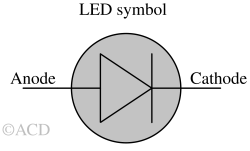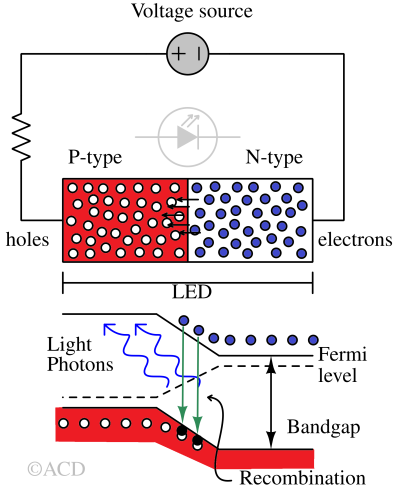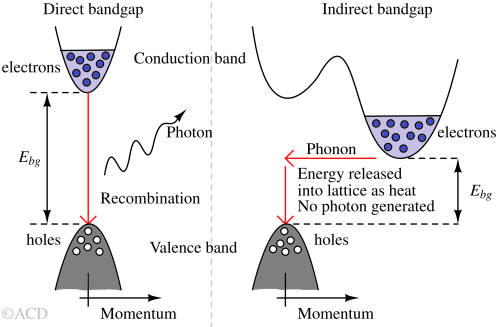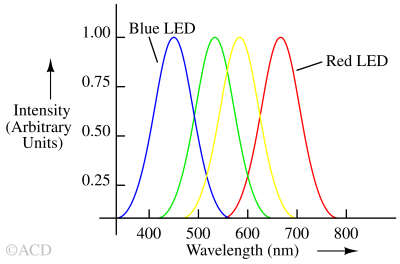Light emitting diodes (LEDs)
What are Light-emitting diodes (LEDs)?¶
Light Emitting Diodes (LEDs) are semiconductors that emit light when an electric current passes through them. An LED is a commonly used light source in various electrical devices. Its applications range from mobile phones to large advertising billboards.
LED symbol and simple LED circuit¶
The LED symbol is the standard symbol for a diode, with the addition of two small arrows denoting the emission of light. In a real LED, the longer terminal is the anode, while the shorter terminal is the cathode.

An LED can be connected to a battery with a resistor in series. The resistor limits the current flowing through the LED, saving it from overheating and permanent damage. The positive terminal of the battery should be connected to the anode of the LED to forward bias the LED. Forward biasing the LED will allow it to emit light. The calculation of the current limiting resistor is mentioned in the following section.

Physics and working principle of LEDs¶
When current passes through an LED, electrons recombine with holes, emitting light. LEDs permit current to flow in the forward direction while blocking it in the reverse direction. Light-emitting diodes are heavily doped p-n junctions. Based on the semiconductor material and doping amount, an LED will emit colored light at a particular spectral wavelength when forward-biased.
P-N Junction, Bandgap energy, and Photon Emission¶
Light-emitting diodes (LEDs) generate light (or infrared radiation) through the recombination of electrons and holes within a PN junction, a phenomenon known as "electroluminescence." The energy band gap of the semiconductor materials used determines the wavelength of the emitted light.

Direct bandgap and Indirect bandgap materials¶
The band gap is the smallest energy difference between the bottom of the conduction band and the top of the valence band.
Direct bandgap¶
In a direct band gap semiconductor, the top of the valence band and the bottom of the conduction band align at the same electron momentum. This means the semiconductor can produce an electron-hole pair straightaway because the electron does not need much momentum.

Indirect bandgap¶
In an indirect band gap semiconductor, the maximum energy of the valence band occurs at a different momentum value than the minimum energy of the conduction band. This means an electron must change its momentum significantly for a photon of energy Ebg to produce an electron-hole pair. To gain momentum, the electron must interact with a lattice vibration called a phonon.
In summary, only direct bandgap semiconductors can emit photons due to no change in the momentum of electrons. Indirect bandgap semiconductors cannot emit light (photons), so they are unsuitable for making LEDs.
Electrical characteristics of LEDs¶
Current-voltage relationship¶
LEDs have a non-linear current-voltage relationship, similar to ordinary diodes, as shown below.

A popular circuit model is used for circuit analysis in the forward-bias region. In this model, a resistor is connected in series with a voltage source. This model is approximate. The voltage source represents the forward bias drop (knee voltage), and the resistor models the voltage variation with the current.

Calculating LED current limiting resistor value¶
The current rating for a standard 5mm LED is 15 - 20mA. Beyond this current value, the LED's longevity may decrease. Some LEDs may support a much higher current. Please refer to the datasheet.
Luminous efficacy and efficiency¶
Luminous efficacy is the ratio of visible light generated (in Lumens) to the electrical power (in Watts) needed to create that light. It is expressed in lumens per watt (lm/W). A higher efficacy value means greater energy efficiency, producing more light for the power consumed.
Luminous efficacy can be normalized by comparing it to the maximum possible luminous efficacy, resulting in a dimensionless measure known as luminous efficiency. Luminous efficiency is expressed in terms of percentage.
Temperature dependence¶
Generally, when Tj rises, the light intensity decreases. This is due to the increased recombination of electrons and holes that do not contribute to light emission. When the temperature increases, VF decreases by 2mV/°C. VF change is an essential consideration in circuit design. With the increase in temperature, the bandgap voltage decreases, resulting in a longer wavelength of light.
Types of LED material and associated color¶
Different types of inorganic semiconductor materials produce different wavelengths of light, which correspond to unique colors. Some of them are mentioned below :
- Gallium Arsenide (GaAs) – infra-red
- Gallium Arsenide Phosphide (GaAsP) – red to infra-red, orange
- Aluminium Gallium Arsenide Phosphide (AlGaAsP) – high-brightness red, orange-red, orange, and yellow
- Gallium Phosphide (GaP) – red, yellow and green
- Aluminium Gallium Phosphide (AlGaP) – green
- Gallium Nitride (GaN) – green, emerald green
- Gallium Indium Nitride (GaInN) – near-ultraviolet, bluish-green and blue
- Silicon Carbide (SiC) and Zinc Selenide (ZnSe) – blue
- Aluminium Gallium Nitride (AlGaN) – ultraviolet
Optical characteristics of LED¶
Optical characteristics of LED decide the intensity, color, luminous efficiency etc. These properties are discussed in details below :
Emission spectrum and color determination¶
The spectrum is a scientific way to determine an LED's color. The spectrum represents intensity (y-axis) with wavelength (x-axis). LEDs typically emit light in a narrow band of wavelengths, which gives them a specific color, such as red, green, blue, or white—for example, the intensity peaks between 600 nm and 650 nm in the Red LED spectrum.

Luminous flux and intensity¶
Luminous flux is the amount of radiant energy emitted per unit of time by a luminous body in light waves. It is represented by ϕ or F, and the unit of measurement is Lumens.
Luminous intensity is the luminous flux per unit solid angle in a given direction. It is represented by I and is measured in (lumen/steradian) or candela (cd). The luminous intensity formula is shown as follows:
$$I=\cfrac{F}{\omega{}}(\text{Lumen/Steradian or Candela})$$
The SI unit of luminous intensity is candela (cd).
Beam angle and light distribution¶
The beam angle of an LED refers to the angle at which light is emitted from the LED. It defines the spread of light and is typically measured in degrees. The beam angle is the angle between the two directions where the light intensity falls to 50% of its maximum value. Normally, the beam angle for LEDs is between 90 and 120 degrees.
Color rendering index (CRI)¶
The Color Rendering Index (CRI) measures how natural colors render under an artificial white light source compared with sunlight. The index is calculated from 0 to 100, with a perfect 100 indicating that the colors of objects under the light source appear the same as they would under natural sunlight. CRIs over 90 are considered good. The light source's spectrum determines the CRI. Light sources with a continuous spectrum have higher CRI (e.g., an incandescent light bulb).
How are white LEDs made?¶

White LEDs are usually created by combining light from different colored LEDs (like red, green, and blue) or by using a blue or UV LED with a phosphor coating that converts the light to a broad spectrum, making it appear white to the human eye. Interesting read here.

LED manufacturing process¶
The primary substrates used to produce LEDs are sapphire (Al2O3), gallium arsenide (GaAs), and silicon carbide (SiC). There is a high lattice mismatch between Sapphire substrates and
GaN LED materials limit the efficiency of blue LEDs, so sometimes, SiC substrates are used. SiC substrates have low lattice mismatch, high thermal conductivity, high resistance to oxidation, chemical inertness, and high mechanical strength.
Advantages of LEDs¶
- Energy efficiency: LEDs are highly efficient in converting electricity into light, making them more energy-efficient than traditional incandescent or fluorescent bulbs.
- Long lifespan: LEDs have a significantly longer operational life than other lighting options, lasting tens of thousands of hours before needing replacement.
- Low heat generation: LEDs produce very little heat compared to traditional bulbs, reducing the risk of fire hazards and making them safer to touch.
- Rapid response time: LEDs turn on and off almost instantly, making them suitable for applications requiring fast response, such as traffic signals and electronic displays.
- Compact size and design flexibility: LEDs are compact, allowing for various shapes and sizes, making them suitable for lighting fixtures and applications.
- Wide range of colors: LEDs can emit light in various colors, and by combining different colors, they can produce full-color displays and lighting effects.
- Environmental friendliness: LEDs do not contain hazardous materials like mercury, often found in fluorescent bulbs, making them more environmentally friendly and easier to dispose of.
Applications of LEDs¶
- General lighting: LED bulbs are used in residential, commercial, and industrial lighting as replacements for traditional incandescent and fluorescent lamps.
- Display technology: LEDs are used in electronic displays such as TVs, computer monitors, and smartphones.
- Automotive lighting: Due to their energy efficiency and durability, LEDs are commonly used in vehicle headlights, taillights, brake lights, and interior lighting.
- Signage and advertising: LEDs are used for illuminated signs and displays due to their brightness and ability to create eye-catching visuals.
- Street lighting: Many cities are transitioning to LED street lighting for energy efficiency and reduced maintenance costs.